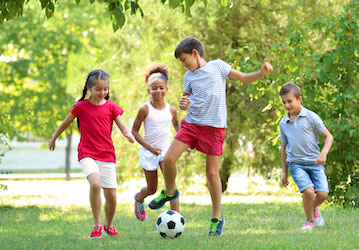Nearly 20% of children between the ages of 6 and 19 are obese, which is up from 10% in the early 1990s. Not only can obesity lead to diabetes, high blood pressure, and other health issues, it’s also a leading reason why young adults are turned away by military recruiters. Nearly 75% of the military's recruiting pool in the United States (ages 17 to 24), are considered ineligible for service, often because they’re overweight or unfit.
Children who exercise and play outside show improved mood, sleep, social skills, self-esteem, balance, strength, coordination, and endurance. Exercise helps school performance too; it’s linked to improved concentration, memory, and classroom behavior. For parents, playing outside with the kids offers a great way to really connect, which is more important than ever for busy families.
Many of the same factors that contribute to obesity in adults contribute to obesity in children and teens, including poor dietary habits, lack of access to healthy food, increased time spent in front of TV and computer screens, and lack of sleep. Most kids today also don’t get the recommended minimum of 60 minutes of exercise a day (and most adults don’t get the recommended 150 minutes a week).
Why kids are overweight
Three factors likely contribute to obesity specific to kids: exercise-deficit disorder, pediatric dynapenia, and physical illiteracy. Some researchers call this combination the “Pediatric Inactivity Triad” (PIT).
- Exercise-deficit disorder describes what happens when children don’t get the recommended minimum 60 minutes of physical activity a day. For today’s youth, this often means they’re not taking part in recess or gym class at school, or playing outside at home. Instead of just calling it “inactivity” or saying kids don’t play enough, researchers now label it as a disorder to highlight how serious the issue is.
- Pediatric dynapenia, or low levels of muscular strength and power, is the second part of PIT. Normal play activities such as running, jumping, and climbing take a certain amount of strength, which can be slow to develop if kids don’t regularly take part in those activities. When children avoid play because they lack the basic abilities that often come from active play, a cycle occurs that can be tough to break: Not enough active play leads to low muscle strength, which makes playing more difficult, which can discourage future play.
- Physical illiteracy describes a lack of confidence, ability, motivation, and knowledge to move well. Remember how discouraging it could be to not be able to throw a ball as far, dance as well, or run as fast as some of the other kids? This discouragement makes it tempting to avoid those activities, contributing even more to the cycle of not getting enough activity and low muscle strength.
These conditions combine to create a difficult nut to crack in the fight against childhood—and future adult—inactivity, obesity, and related health problems. The best way to attack the Pediatric Inactivity Triad is to find and address the barriers that limit a child’s motivation to play.
6 ways to help optimize your child’s performance—now and in the future:
- Make exercise part of your family’s routine. Kids with active parents tend to be more active too. Go for walks after dinner, hikes on the weekend, or play active games together in the yard or park rather than watching TV.
- Encourage participation in sports or activities such as dancing, swimming, biking, or yoga. Getting your kids to be more active doesn’t stop at signing them up though. Showing your support by staying to watch practice and attending games, competitions, and recitals can go a long way in keeping your kids engaged and motivated.
- Structure screen time. The American Academy of Pediatrics suggests limiting entertainment screen time to less than 2 hours a day. Set a schedule for when your kids can watch TV or be on the computer or handheld devices. In those off hours, get out and play!
- Make exercise more fun. Try listening to music or tracking your steps while you exercise. Making exercise into a game can help keep kids interested and excited.
- Let them fall. Parents often want to protect their children them from getting hurt, but it’s important to strike a balance between protecting them and being overprotective. Climbing and running around a playground helps build strength, coordination, and brain development. Be careful not to discourage the types of physical activity that could limit this potential for growth.
- Encourage your kids to keep trying. Losing a game, missing a shot, or not being able to perform a complicated move can be frustrating and make your child want to quit. Rather than avoid failure, use it as a learning point. What can your child practice differently or do better? Overcoming that loss or challenge will be more rewarding in the end and keep your child interested and motivated.
Bottom line
Telling your kids to go out and play might not be enough to keep them active. But once you identify some of the barriers to exercise that lead to pediatric inactivity, with a little bit of structure and lots of encouragement, you can create a culture that promotes a healthy, happy, and active lifestyle for your whole family.
